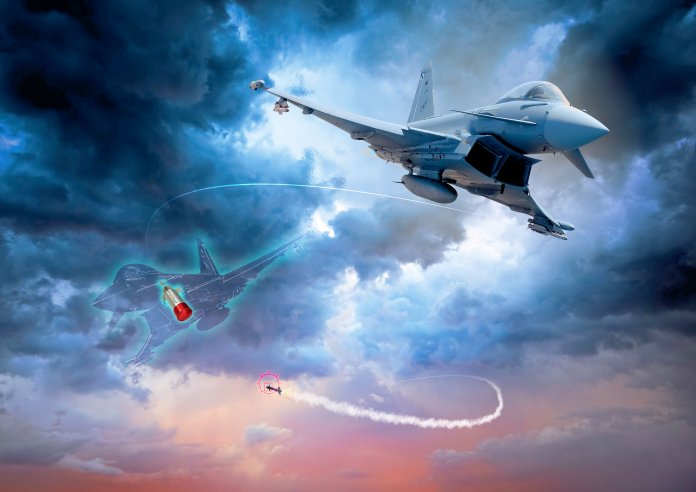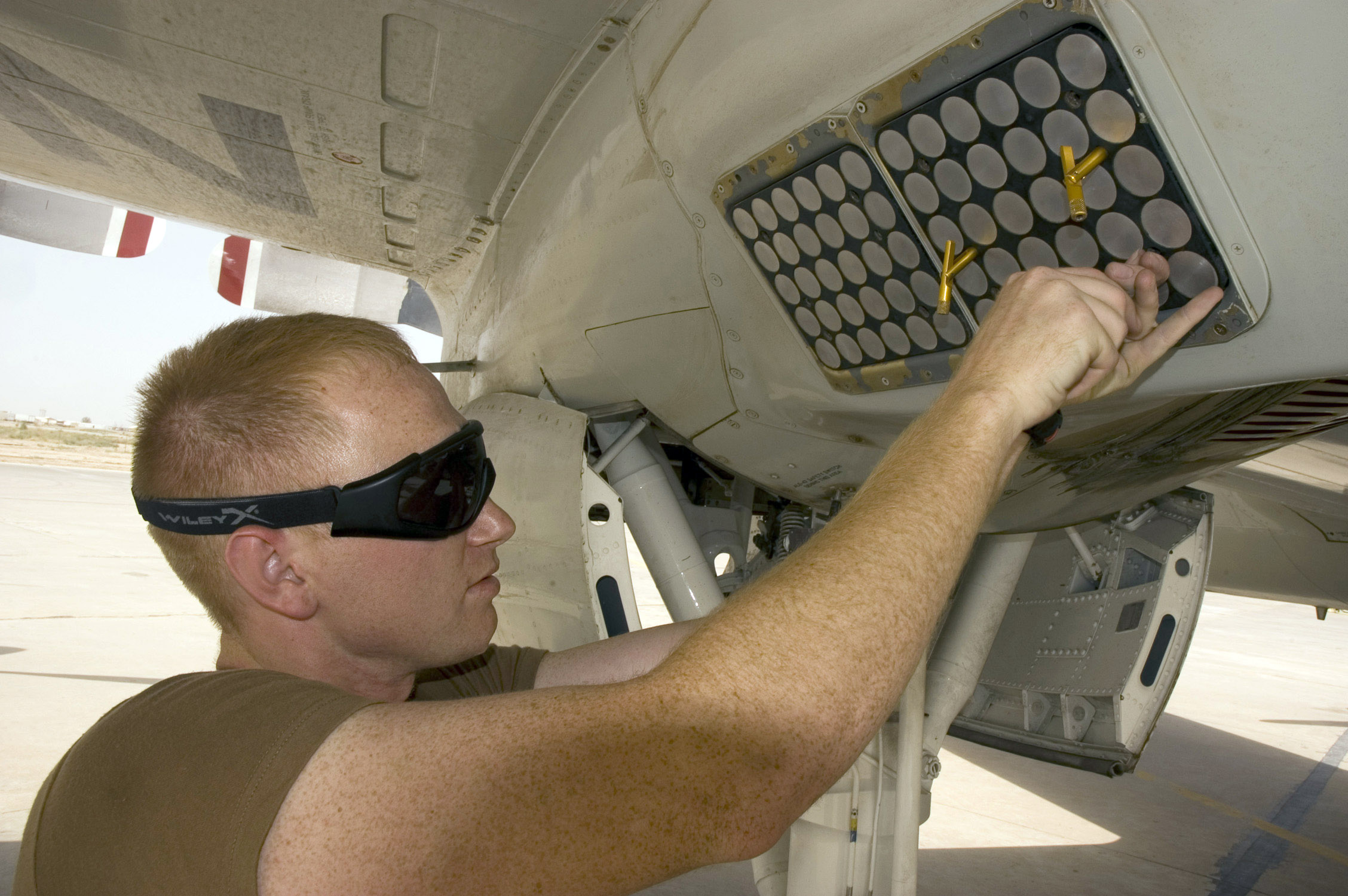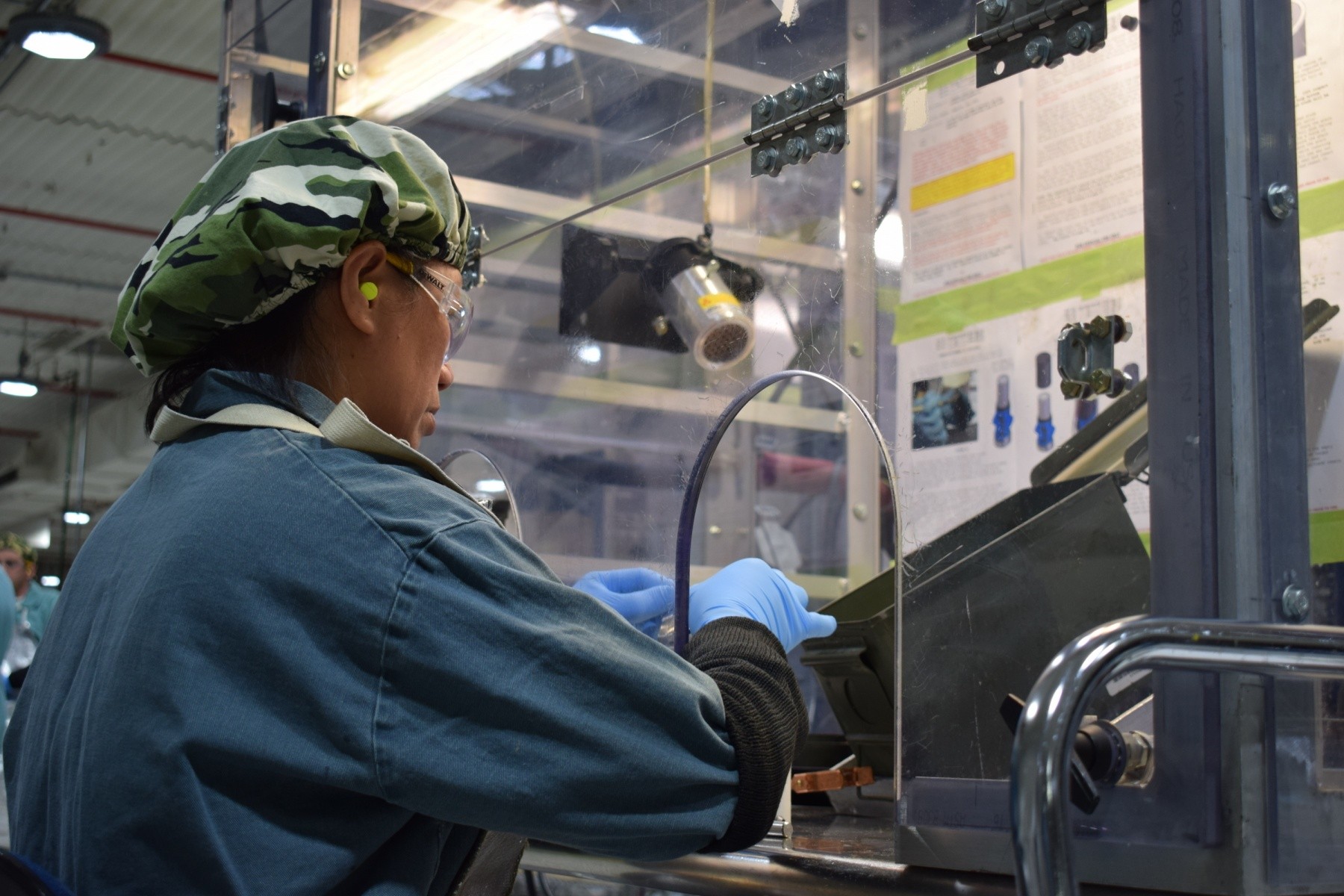
Deflection and deception is the key to survival against missile attack and the expendables market is developing smarter products to keep aircraft safe.
Since its earliest days, dominance in aerial warfare has swung between defence and offence, with the former having the upper hand in the first decades of the 21st Century. In contested environments, today’s warplanes face a broad spectrum of threats from both the ground and in the air and it is probably fair to say that survival depends in large part on the provision of a countermeasures capability with which to disrupt an enemy’s engagement sequence. As might be expected, such provision is costly both in terms of procurement and real estate occupied in its high-end forms. Accordingly, airborne expendable decoys present both an effective level of protection and one which is affordable and easy to operate.
Traditionally, airborne expendables have taken the form of chaff and infra-red (IR) decoy flares. Chaff is aimed at fire-control, acquisition and search radars and functions by generating multiple responses which mask a true target ‘echo’ within a radar system. The measure can be used to screen incoming strike forces as well as providing a means of disrupting a weapon system’s engagement sequence for long enough to allow the dispensing platform to escape it. For their part, IR decoy flares are designed to generate a target that is more attractive to an incoming missile IR seeker than the signature of the real target. Initially, such devices were effective against classic ‘tail-chase’, first generation IR guided air-to-air and ground-to-air missile seekers. Naturally enough, defence technology developed counters to these, with seekers that are ‘all aspect’ and/or capable of discriminating (rate-bias and spectral) between the IR signature of a target and that of a decoy being developed. Countering the countermeasures has led to the creation of both advanced flare compositions and methods of dispensing which cover 360º rather than just the rearward hemisphere. Examples here include kinematic (effectively, the geometry of movement) and pyrophoric types, with the former being designed to better mimic the flightpath of the target being engaged, while that later make use of materials that ignite spontaneously on contact with air and which generate large IR signatures. A major advantage of this latter type of device is that it generates virtually no visual signature which in conventional flare types gives away the position of the launch platform. Indeed, the brightness of conventional decoy flares is such as to have seen their successful use as ‘shows of force’ during anti-insurgent operations. Here, the fear and shock engendered by the sight of ignited flares is known to have broken up attacks without the use of kinetic force.
Almost inevitably, conventional IR decoy flares have their downside, with the most obvious being the sensitivity of their constituent materials (magnesium and teflon with a viton binder – abbreviated to MTV – in ‘classic’ compositions) to static electricity. According to a US Army hand-out, “even the smallest spark can cause a great catastrophe”, a view that is attested to by major explosions at flare manufacturing plants in the UK and US which have killed and injured workers.
Turning to chaff, similar geometric considerations are to the fore in that once dispensed (and when being used for platform self-protection from direct attack), the measure needs to provide all round cover rather than simply an obscuring cloud in the launch vehicle’s rear hemisphere. Again, the effectiveness of both chaff and flares is constrained by the capacity of the magazines that holds them within the airframe prior to launch. Innovative ways round this have included the creation of ‘blocks’ which increase the number of cartridges (both chaff and IR decoy flares are packaged in cartridges that are either square – with the NATO standard being 1x1in or 2x1in – or round in format) per magazine and the BOL dispenser which can be installed in redundant space within a missile launch rail and which makes use ‘bread slices’ mounts that hold multiple payloads and which break up once ejected.

Smart Decoys
Mention of dispensers brings into view the emergence of ‘smart’ systems that can utilise multiple decoy types, provide round counting and system management and can operate in manual, semi-automatic and automatic modes. By way of example, the American AN/ALE-47 equipment (one of the most widely used globally) offers six pre-programmed dispenser sequences/programmes in manual mode, optimum dispenser sequences for crew initiation in semi-automatic mode and autonomous dispensing sequences based on external sensor/avionic inputs in fully automatic.
So far this survey has concentrated on ‘classical’ off-board decoys which, most recently, have been joined by a new generation of expendable active decoys (EADs). While not a new idea – the American Primed Oscillator Expendable Transponder (POET) device was patented as early as 1975 – the latest generation of EADs introduce digital radio frequency memory (DRFM) technology as a means of countering multiple threats with a battery-powered off-board expendable that can be pre-programmed to optimise performance. Again, a key ‘selling point’ of the EAD is that it is billed as being equal to towed radar decoys in effect, is compatible with existing ‘smart’ dispenser systems and does not require the dedicated launch/recovery sub-system needed to handle the towed option.
To summarise, chaff and IR decoy flares provide basic, relatively low-cost platform protection which is easy to install and operate and which (with the addition of ‘smarts’) is becoming sophisticated enough to keep abreast of the evolution of the threat. This said, maximising the effect of both measures requires a combination of optimised dispensing regimes that are combined with appropriate platform manoeuvres.
Decoy Market Analysis
Moving forward, the remainder of this survey takes the form of a market survey, with Armada being able to identify decoy dispenser manufacturers in America (BAE Systems/ Extant Aerospace), Denmark (Terma), France (MBDA France/Alkan), Israel (BAE Systems Rokar), Italy (MES), Pakistan (GIBS), the Russian Federation, Sweden (Saab Defence), Turkey (Aselsan/MiKES) and the UK (Thales UK). With regard to chaff, examples of chaff manufacturers include the US contractor Armtec Defense Technologies, France’s Lacroix and the UK’s Chemring Group, while IR decoy producers include America’s Alloy Surfaces, Armtec Defense Technologies and Kilgore Flares, France’s Lacroix and the UK’s Chemring. With regard to EADs, Leonardo’s BriteCloud device appears to be the only fully developed example that is available and has been procured for use aboard the UK’s now retired Tornado fleet (see following).

Taking chaff manufacturer first, Armtec bills itself as producing broad frequency coverage material that is effective across the 2-40 GHz frequency band, provides “high” radar “reflectivity”, is subject to “minimal” bird-nesting (that is, the individual filaments of the payload do not clump together on release) and can be tailored to meet specific customer requirements. With regard to specifics, the recent past has seen the contractor produce RR-129, -144, -170, -180, -188 and -196 round and square format cartridges that collectively covered the 2-18 GHz section of the specified frequency range. For its part, French producer Lacroix offers the 1x1in LEM 170 (designed for helicopter and fixed wing applications and which covers the 2-40 GHz band), the 40mm diameter LEM 677 (again covering the 2-40 GHz band and which is designed for use aboard Mirage 2000 and Rafale fast jets) and the 50mm LEM 505 (a form/fit/function equivalent for use in Russian dispensers) cartridges.
Turning to the UK, the Chemring Group produces a range of 1x1in (the RR170 Mk3 Type 1) and circular format (the CM 26mm Mk3 Type 1, the CM 50mm Mk3 Type 1 and the 36mm CCM129 A/AL and CCM144 A/AL) chaff cartridges of which, the RR170 Mk 3 Type 1, the CCM129 A/AL and the CCM144 A/L are all designed for helicopter, fixed-wing and fast-jet applications. For their part, the company’s CM 26mm and CM 50mm Mk 3 Type 1s are form/fit/function equivalents for Russian devices. Alongside these, Chemring also produces BOL chaff ‘bread slices’ together with Modular Expendable Block (MEB) Mk1 Type 1, Mk3 Type 1 and Mk4 Type 1 payload enlargement units. Of these, the Mk1 and Mk3 Types 1 have a capacity of 60 decoys, while the Mk4 Type four provides accommodation for eight decoys and eight MEB ‘Minis’. Again, all three variants are billed as being suitable for use in helicopter, fixed-wing and fast-jet applications.
With regard to IR decoy flares, American contractor Alloy Surfaces (a part of Chemring USA) makes use of ‘special materials’, that is, pyrophoric compositions. Here, the company produces the 1x1in M211, MJU-50A/B and MJU-64/B pyrophoric cartridges, the 2x1in MJU-53/B device and the L5A2 pyrophoric BOL dispenser payload. Again, Chemring USA also offers (via its Kilgore component) the M206 and the 2x1in KC-002 (a form, fit and function replacement for the MJU-7A/B device) and MJU-53/B conventional MTV flares. For its part, Armtec’s recent range of IR decoys has included its proprietary range of ARM 1x1in square and circular format cartridges together with MJU-7A/B, -10/B, -32/B, -38/B, -47/B, -48/B (kinematic and with a ¼ MTV and ¾ pyrophoric filling), -53/B, -59/B and -61/B types.
France’s Lacroix IR decoy flare portfolio is divided into helicopter, transport aircraft and fast-jet applications, with the first of these encompassing its 1x1in LIR 110 MTV, 1x1in LIR 111 spectral and 1x1in LIR 112 kinematic cartridges. For transport aircraft, the company offers the LIR 110 together with the 2x1in LIR 120 MTV (tailored to the A400M) and the 2x1in LIR 121 spectral devices. Recent fast-jet applications are understood to have included the 40mm diameter LIR 410 MTV and LIR 411 spectral rounds together with the 60mm diameter LIR 659 and LIR 684 MTV designs. Here, all Lacroix’s circular format cartridges are designed for use aboard the Mirage 2000 and Rafale aircraft.

In the UK, Chemring’s currently identifiable IR decoy flare range is made-up of 15 configurations that are designated as the CM26mm Mk8 Type 1, CM36mm Mk4 Type 2, CM50mm Mk3 Type 2, CM55 × 200mm (Spectral) L2A1, CM55mm DSTL41, CM55mm No4 Mk2 Type 1, CM118 Mk3 Type 3, CM118A DSTL22, CM118T L7A7, CM218 Mk3 Type 1, CM218 Mk3 Type 3, CM DSTL6A, CM DSTL73, CM DSTL81 and the CM DSTL 83 devices. Of these, the CM118 Mk3 Type 3, CM118A DSTL22, CM118T L7A7 and CM DSTL73 are packaged in 1x1in cartridges, while the CM218 Mk3 Type 1, CM218 Mk3 Type 3, CM DSTL6A, CM DSTL81 and CM DSTL83 are all 2x1in devices. Again, CM118 Mk3 Type 3 is an M206 equivalent for transport and helicopter applications; CM118A DSTL22 is aimed at 3rd generation missile seekers and is designed for transports and helicopters; CM118T L7A7 is the fast jet equivalent of DSTL22 and CM DSTL73 is another anti-3rd generation seeker decoy for transport and helicopter applications.
Turning to the 2x1in cartridges, CM218 Mk3 Type 1 is an MJU-7 series equivalent; CM218 Mk3 Type 3 is a fast-jet MJU-7 equivalent that is aimed at spectral discriminating seekers; CM DSTL 6A is a transport/helicopter round for use against 3rd generation seekers; CM DSTL81 is a fast-jet counter to spectral discriminating seeker heads and CM DSTL 83 is a transport aircraft equivalent of DSTL81. Of Chemring’s round format decoy flares, the CM26mm Mk8 Type 1 is a form/fit equivalent of the Russian L056V device; CM36mm Mk4 Type 2 is an MTV round for use in AN/ALE-39B and -47 dispensers; CM50mm Mk3 Type 2 is a form/fit equivalent of the Russian PPI-50 flare; CM55x200mm (spectral) L2A1 is (as its designation suggests) is a spectrally matched decoy for use with the Typhoon fast-jet; CM55mm DSTL41 is a fast-jet device that incorporates both MTV and spectrally-matched compositions and CM55mm No 4 Mk2 Type 1 is designed for use with the BOZ and Thales (Vinten) 400 series dispensers.
Last (but by no means least), Leonardo’s BriteCloud EAD can be configured in 55mm round (BC55) and 2x1in square (BC218) formats and operates within the H- to J- frequency bands. As such, it is a self-contained, battery powered device that is (as noted earlier) based around DRFM technology and which is claimed to have a ‘very quick’ deployment time. Again, the device is designed for launch from conventional decoy dispensers and as such, is reported to have been trialled aboard F-16, Gripen and Tornado fast jets, deployed as an operational countermeasure aboard the RAF’s now withdrawn Tornado fleet and (as of 2021) to have been undergoing due diligence for use on the Eurofighter Typhoon. Elsewhere, Leonardo bills the device as having been ‘future proofed’, as being mission re-programmable with (as of 2021) an in-dispenser re-programming capability being developed and as having a significantly lower procurement price that equivalent towed radar decoy technology.
While compressed, it is hoped that the foregoing will have given the reader some insight into the nature of the current generation of airborne offboard expendables and their continued value as components of an aircraft’s self-defence armoury in increasingly potent threat environments.
by Martin Streetly












